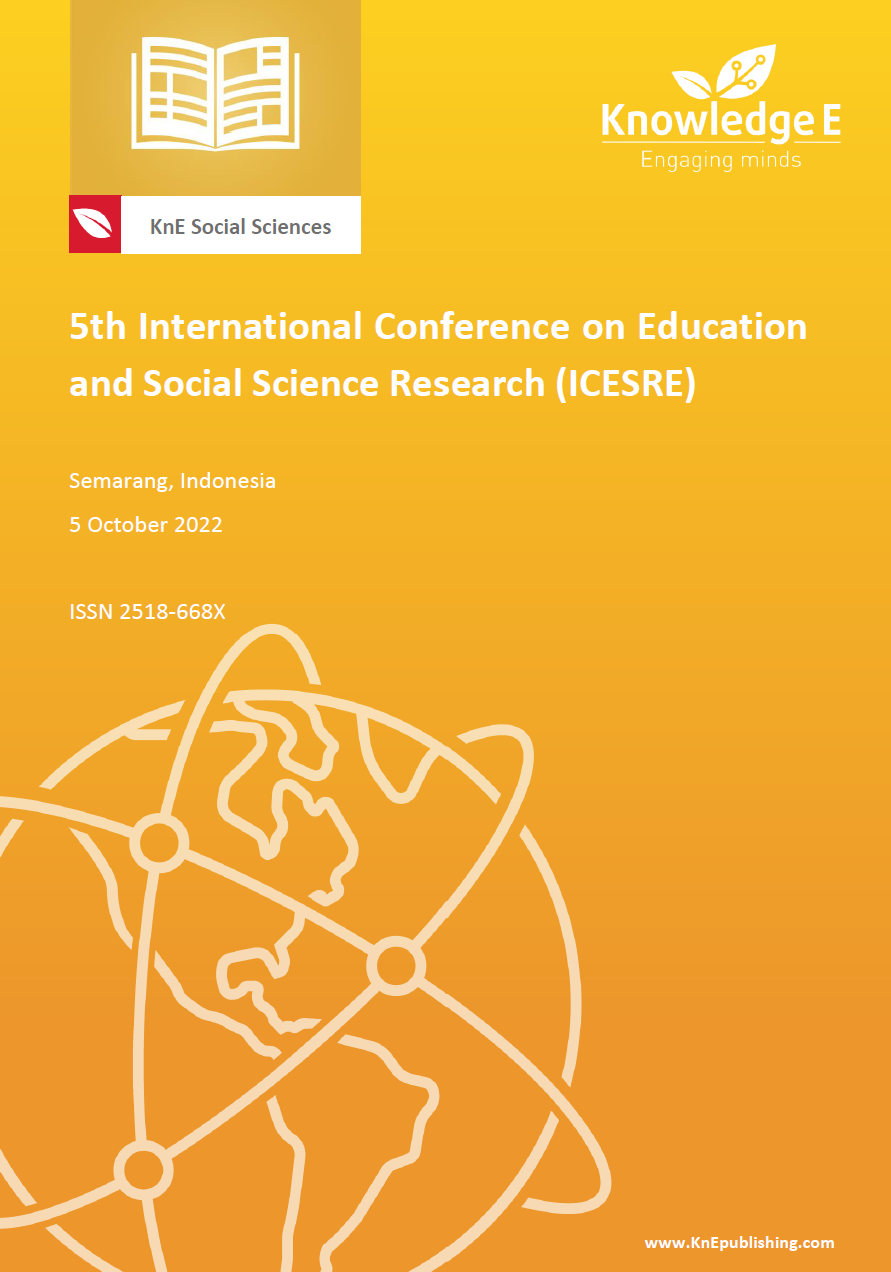Factors that Affect the Intention to Use E-learning among University Lecturers
DOI:
https://doi.org/10.18502/kss.v7i19.12427Abstract
University lecturers are one among many people who have been affected by the pandemic. Lecturers were forced to use a learning management system, grapple with video conferencing software, and cope with various unpredictable technical issues. In short, external forces seem to pressure lecturers to refine their digital skills and use e-learning as the only way to deliver the materials whenever they were unable to meet face-to-face with students. This study investigates what factors determined lecturers’ intention to use e-learning in their classes. The results of this study suggest that technology literacy and attitude have positive correlations with lecturers’ intention to use e-learning.
Keywords: intention to use e-learning; attitude; self-efficacy; technology; literacy; technology comfort level
References
[2] Roblyer M, Doering AH. Integrating educational technology into teaching. USA: Pearson; 2014. 486 p.
[3] Mailizar M, Burg D, Maulina S. Examining university students’ behavioural intention to use e-learning during the COVID-19 pandemic: An extended TAM model. Education and Information Technologies. 2021;26:7057–7077.
[4] Buchanan T, Sainter P, Saunders G. Factors affecting faculty use of learning technologies: Implications for models of technology adoption. Journal of Computing in Higher education. 2013;25:1–1.
[5] List A. Defining digital literacy development: An examination of pre-service teachers’ beliefs. Computers & Education. 2019;138:46–58.
[6] Marsh E. Research anthology on digital transformation, organizational change, and the impact of remote work. Hershey, USA: IGI Global; 2021. Understanding the effect of digital literacy on employees’ digital workplace continuance intentions and individual performance. p. 1638–1659.
[7] Tejedor S, Cervi L, Pérez-Escoda A, Jumbo FT. Digital literacy and higher education during COVID-19 lockdown: Spain, Italy, and Ecuador. Publications. 2020;8:48.
[8] Geng S, Law KM, Niu B. Investigating self-directed learning and technology readiness in blending learning environment. International Journal of Educational Technology in Higher Education. 2019;16:1–22.
[9] Chau KY, Law KM, Tang YM. Impact of self-directed learning and educational technology readiness on synchronous E-learning. Journal of Organizational and End User Computing ( JOEUC). 2021;33:1–20.
[10] Murniati CT, Hartono H, Nugroho AC. Self-directed learning, self-efficacy, and technology readiness in e-learning among university students. KnE Social Sciences. 2022:213–224.
[11] Maldonado UP, Khan GF, Moon J, Rho JJ. Elearning motivation and educational portal acceptance in developing countries. Online Information Review. 2011;35:66.
[12]Ø Sørebø, Halvari H, Gulli VF, Kristiansen R. The role of self-determination theory in explaining teachers’ motivation to continue to use e-learning technology. Computers & Education. 2009;53:1177–1187.
[13] Wang Y, Liu X, Zhang Z. An overview of e-learning in China: History, challenges and opportunities. Research in Comparative and International Education. 2018;13:195– 210.
[14] Gagnon M, Legare F, Labrecque M, Fremont P, Cauchon M, Desmartis MA. Perceived barriers to completing an e-learning program on evidence-based medicine. Informatics in Primary Care. 2007;15:83–91.
[15] Wang Y, Liu X, Zhang Z. An overview of e-learning in China: History, challenges and opportunities. Research in Comparative and International Education. 2018;13:195– 210.
[16] Mousavi A, Mohammadi A, Mojtahedzadeh R, Shirazi M, Rashidi H. E-Learning Educational Atmosphere Measure (EEAM): A new instrument for assessing estudents’ perception of educational environment. Research in Learning Technology. 2020;28:2308.
[17] Creswell JW, Creswell JD. Research design: Qualitative, quantitative and mixed methods approaches. 5th ed. Thousand Oaks, California: SAGE Publications; 2018. 304 p.
[18] Liu M, Navarrete CC, Scordino R, Kang J, Ko Y, Lim M. Examining teachers’ use of iPads: Comfort level, perception, and use. Journal of Research on Technology in Education. 2016;48:159–180.
[19] Unruh T, Peters ML, Willis J. Flip this classroom: A comparative study. Computers in the Schools. 2016;33:38–58.
[20] Abdullah F, Ward R. Developing a General Extended Technology Acceptance Model for E-Learning (GETAMEL) by analysing commonly used external factors. Computers in Human Behavior. 2016;56:238–256.
[21] Al-Rahmi WM, Othman MS, Yusuf LM. Exploring the factors that affect student satisfaction through using e-learning in Malaysian higher education institutions. Mediterranean Journal of Social Sciences. 2015;6:299.
[22] Chu RJ, Tsai CC. Self directed learning readiness, Internet self efficacy and preferences towards constructivist Internet based learning environments among higher aged adults. Journal of Computer Assisted Learning. 2009;25:489–501.
[23] Hsia JW, Chang CC, Tseng AH. Effects of individuals’ locus of control and computer self-efficacy on their e-learning acceptance in high-tech companies. Behaviour & Information Technology. 2014;33:51–64.
[24] Saadé RG, Kira D. Computer anxiety in e-learning: The effect of computer selfefficacy. Journal of Information Technology Education: Research. 2009;8:177–191.
[25] Van Dinther M, Dochy F, Segers M. Factors affecting students’ self-efficacy in higher education. Educational Research Review. 2011;6:95–108.
[26] Kisanga D. Determinants of teachers’ attitudes towards e-learning in Tanzanian higher learning institutions. International Review of Research in Open and Distributed Learning: IRRODL. 2016;17:109–125.
[27] Cidral WA, Oliveira T, Di Felice M, Aparicio M. E-learning success determinants: Brazilian empirical study. Computers & Education. 2018;122:273–290.
[28] Pala SM, Basibüyük A. The predictive effect of digital literacy, self-control and motivation on the academic achievement in the science, technology and society learning area. Technology, Knowledge and Learning. 2021:1–7.
[29] Mohammadyari S, Singh H. Understanding the effect of e-learning on individual performance: The role of digital literacy. Computers & Education. 2015;82:11–25.

